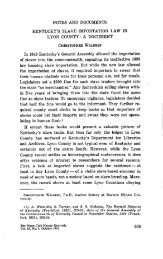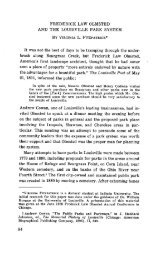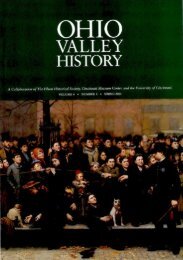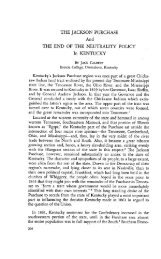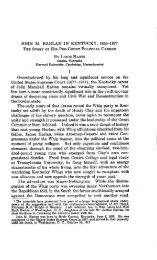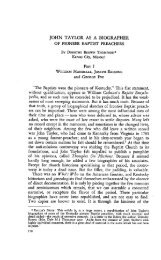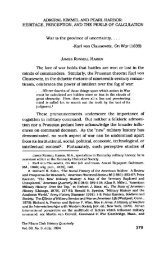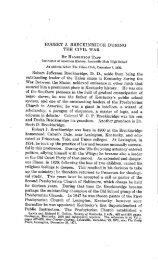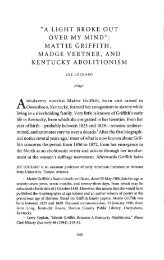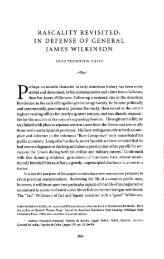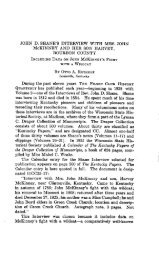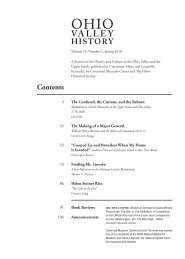Himlerville: Hungarian Cooperative Mining in Kentucky - The Filson ...
Himlerville: Hungarian Cooperative Mining in Kentucky - The Filson ...
Himlerville: Hungarian Cooperative Mining in Kentucky - The Filson ...
You also want an ePaper? Increase the reach of your titles
YUMPU automatically turns print PDFs into web optimized ePapers that Google loves.
520 <strong>The</strong> <strong>Filson</strong> Club History Quarterly [October<br />
were nearly impassable because of mud and deep ruts. Add<strong>in</strong>g<br />
to the transportation problems was Mart<strong>in</strong> County's hilly terra<strong>in</strong><br />
which made travel difficult <strong>in</strong> the best weather. <strong>M<strong>in</strong><strong>in</strong>g</strong><br />
equipment weigh<strong>in</strong>g between ten and twenty tons had to be<br />
floated across Tug River and then dragged the rest of the way<br />
by horses through the mud. Thousands of tons of concrete and<br />
brick had to be transported to <strong>Himlerville</strong> <strong>in</strong> this way. When the<br />
snows melted <strong>in</strong> early spr<strong>in</strong>g, conditions were so bad that it<br />
took six weeks to transport an extremely heavy piece of equipment<br />
from Kermit to <strong>Himlerville</strong>. 21 Several pieces of m<strong>in</strong><strong>in</strong>g<br />
equipment had not been delivered when the <strong>Himlerville</strong> works<br />
were first <strong>in</strong>spected on 9 November 1920 by <strong>in</strong>vestigators from<br />
the <strong>Kentucky</strong> Department of M<strong>in</strong>es and M<strong>in</strong>erals. Yet the im:<br />
migrants would eventually complete this enormous task of build<strong>in</strong>g<br />
a coal town.<br />
<strong>The</strong> <strong>Hungarian</strong>s quickly realized that their major problem<br />
was transportation and that their <strong>in</strong>vestment would be worth-<br />
less unless Mart<strong>in</strong> County was connected to Kermit. To accomplish<br />
this, Himler organized• the Kermit-Warfield Bridge Com-<br />
pany <strong>in</strong> 1919 to construct a steel and concrete bridge across Tug<br />
River between Kermit and Warfield, a small community near<br />
<strong>Himlerville</strong> on the banks of Tug River. <strong>The</strong> bridge company was<br />
capitalized at $125,000, and all its shareholders were m<strong>in</strong>e operators<br />
who owned coal and timber lands on either the <strong>Kentucky</strong><br />
or West Virg<strong>in</strong>ia side of Tug River. Officers of the company<br />
were Daniel Elmer Hewitt, a Hunt<strong>in</strong>gton, West Virg<strong>in</strong>ia, lumber<br />
and coal baron, president; Mart<strong>in</strong> Himler, vice president;<br />
Eugene Lang, treasurer; and M. W. Hale, secretary.<br />
Work on the bridge, which was expected to take ten months<br />
to complete, began <strong>in</strong> July 1919. By November the eng<strong>in</strong>eers had<br />
discovered a bed of quicksand eighteen feet below the riverbed.<br />
Only by drill<strong>in</strong>g to a depth of thirty to forty feet could they<br />
21 Bagger, "Himler," 148; Chapman, "Influence of Coal," 227-29.<br />
22 <strong>Kentucky</strong>, Department of M<strong>in</strong>es, Annual Report, 1920, p. 201.<br />
23 "Tug River Bridge at Warfield, Ky."



